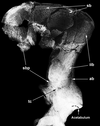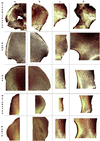Oreopithecus was a bipedal ape after all: evidence from the iliac cancellous architecture
- PMID: 10411955
- PMCID: PMC17596
- DOI: 10.1073/pnas.96.15.8795
Oreopithecus was a bipedal ape after all: evidence from the iliac cancellous architecture
Abstract
Textural properties and functional morphology of the hip bone cancellous network of Oreopithecus bambolii, a 9- to 7-million-year-old Late Miocene hominoid from Italy, provide insights into the postural and locomotor behavior of this fossil ape. Digital image processing of calibrated hip bone radiographs reveals the occurrence of trabecular features, which, in humans and fossil hominids, are related to vertical support of the body weight, i.e., to bipedality.
Figures



Similar articles
-
Insights into the lower torso in late Miocene hominoid Oreopithecus bambolii.Proc Natl Acad Sci U S A. 2020 Jan 7;117(1):278-284. doi: 10.1073/pnas.1911896116. Epub 2019 Dec 23. Proc Natl Acad Sci U S A. 2020. PMID: 31871170 Free PMC article.
-
Hip bone trabecular architecture shows uniquely distinctive locomotor behaviour in South African australopithecines.J Hum Evol. 1999 Feb;36(2):211-32. doi: 10.1006/jhev.1998.0267. J Hum Evol. 1999. PMID: 10068067
-
Ape-like or hominid-like? The positional behavior of Oreopithecus bambolii reconsidered.Proc Natl Acad Sci U S A. 1997 Oct 14;94(21):11747-50. doi: 10.1073/pnas.94.21.11747. Proc Natl Acad Sci U S A. 1997. PMID: 9326682 Free PMC article.
-
Acquisition of bipedalism: the Miocene hominoid record and modern analogues for bipedal protohominids.J Anat. 2004 May;204(5):385-402. doi: 10.1111/j.0021-8782.2004.00290.x. J Anat. 2004. PMID: 15198702 Free PMC article. Review.
-
A review of trabecular bone functional adaptation: what have we learned from trabecular analyses in extant hominoids and what can we apply to fossils?J Anat. 2016 Apr;228(4):569-94. doi: 10.1111/joa.12446. Epub 2016 Feb 16. J Anat. 2016. PMID: 26879841 Free PMC article. Review.
Cited by
-
Homeotic evolution in the mammalia: diversification of therian axial seriation and the morphogenetic basis of human origins.PLoS One. 2007 Oct 10;2(10):e1019. doi: 10.1371/journal.pone.0001019. PLoS One. 2007. PMID: 17925867 Free PMC article.
-
A rare case of pelvic bone duplication.Skeletal Radiol. 2018 Aug;47(8):1171-1175. doi: 10.1007/s00256-017-2869-1. Epub 2018 Feb 14. Skeletal Radiol. 2018. PMID: 29445931
-
A partial hominoid innominate from the Miocene of Pakistan: description and preliminary analyses.Proc Natl Acad Sci U S A. 2015 Jan 6;112(1):82-7. doi: 10.1073/pnas.1420275111. Epub 2014 Dec 8. Proc Natl Acad Sci U S A. 2015. PMID: 25489095 Free PMC article.
-
The evolution of the vestibular apparatus in apes and humans.Elife. 2020 Mar 3;9:e51261. doi: 10.7554/eLife.51261. Elife. 2020. PMID: 32122463 Free PMC article.
-
The environmental context of human evolutionary history in Eurasia and Africa.J Anat. 2008 Apr;212(4):377-93. doi: 10.1111/j.1469-7580.2008.00872.x. J Anat. 2008. PMID: 18380862 Free PMC article. Review.
References
-
- Moyá-Solá S, Köhler M. C R Acad Sci Paris. 1996;324:141–148.
-
- Harrison T, Rook L. In: Function, Phylogeny, and Fossils: Miocene Hominoid Origins and Adaptations. Begun D R, Ward C W, Rose M D, editors. New York: Plenum; 1997. pp. 327–362.
-
- Coppens Y, Senut B, editors. Origine(s) de la Bipédie ches les Hominidés. Paris: Centre National de la Recherche Scientifique; 1991.
Publication types
MeSH terms
LinkOut - more resources
Full Text Sources
Research Materials
Miscellaneous

